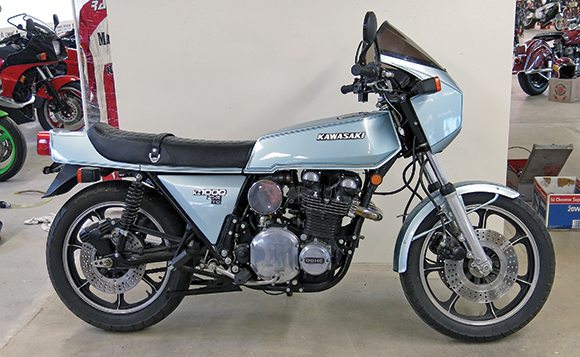
As the old adage goes, when enough is good, more is better. In late 1977, Kawasaki’s new Z1-R, a somewhat sexier version of the KZ1000, was good for a quarter-mile in a hair under 12 seconds at 110 mph. For the late ’70s, that was pretty impressive. And the handling was acceptable for those long-ago times, although pretty Stone Age in comparison to some of the European bikes.
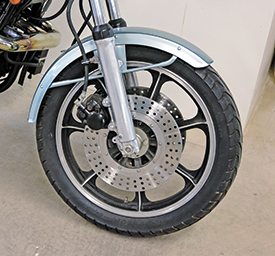
Then along came someone who decided that what the public really wanted, needed, was a Z1-R with a turbocharger. And you could dial up the turbo’s boost to any level you liked, from a modest six psi to an arm-stretching 10 psi. Anything beyond that would usually lead to engine-shattering results.
All of this extra power did not come cheap. The stock Z1-R cost a reasonable $3,695, while the TC version went for $4,995 out the showroom door…about 18 grand in these inflated times. Yes, these turbos were to be found at Kawasaki dealers—with one major caveat: No warranty. Who the heck would drop that kind of money on a bike the engine of which could disintegrate at any time—presuming you did not pay attention to the boost indicator.
In the 1970s, the Big Four were all taking the quarter-mile game quite seriously. Back in ’72 the new Kawasaki 903cc Z-1 was the one to beat at the dragstrips, running 12.5 seconds and well over 100 mph. In ’77, the 1,015cc Z1-R held onto the quarter-mile title with an 11.95. And then serious competition arrived, first in the form of Yamaha’s XS1100, followed by Honda’s 6-cylinder CBX and then Suzuki’s GS1000—all doing better sub-12s than the Kawasaki. Sales plummeted.
Oh, the shame of it all! Something had to be done.
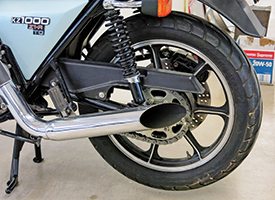
The stock Z1-R was a pretty impressive bike all by itself. A UJM, with four in-line short-stroke (70mm bore, 66mm stroke) cylinders, two shim-adjusted valves per cylinder, compression ratio a nominal 8.7:1, fed by four 28mm Mikuni carburetors. A strong crankshaft was running on four caged roller bearings, with a chain between the middle cylinders going up to the two overhead camshafts. At the rear wheel were a little over 70 horses, at a reasonable 7,500 rpm. Although Kawasaki had advertised it as a 90-hp motor—measured at the crankshaft. Torque was 50-plus lb-ft at 7,000 rpm.
The frame was a full cradle with double downtubes, and reinforcement at the steering head to keep the flexing to a minimum. Japan was still learning the art of chassis design, and had things pretty much figured out for the straight line, but tended to be a bit wavery when it came to cornering. With a rake of 26 degrees, 3.3 inches of trail, a 3.50-18 tire on the front, 4.00-18 on the back, a wheelbase of 58.7 inches and wet weight of 565 pounds, the Z1-R was not a motorcycle to curve gracefully into a bend in the road, but required a forceful movement on the handlebars. The triple disc brakes were good, but the Kayaba suspension units were a weak point, especially at the back.
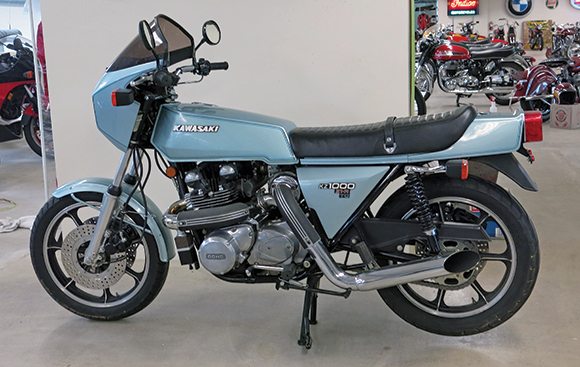
The fellow who figured out how to regain the title of Stoplight King was a Kawasaki executive, Alan Masek, who had his contacts in the hot-rod world. He had started a company called Turbo Cycle Corporation (TCC), working with American Turbo-Pak (ATP) and specializing in aftermarket turbo kits for the power-hungry. To boost (ha, ha!) Z1-R sales, Masek told ATP that he wanted to have them make a kit for that model, so they bolted on a collector exhaust system, which boosted a Rajay turbo that pushed the fuel through a 38mm Bendix accelerator-pump carb, which required a fuel pump. And, to ATP’s credit, they made the whole package look very neat indeed. All for a modest $1,305 above the $3,695 MSRP.
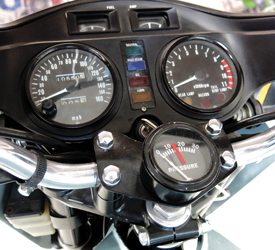
Suddenly the herd of 70 horses had grown to well over 100, with a boost of 6 psi. The recommended limit was 8 psi—though for a short time only. If the owner wanted more, he was advised to tear the engine apart, reinforce the crankshaft and other internals. Inevitably there were individuals who would want to test the limits without bothering to do the recommended modifications, as all they had to do was get out a screwdriver and adjust the waste gate, which metered pressure into the system. With 10 pounds of boost the TCs were running 10.8s and 120 mph.
The turbo model, labeled as the Z1-R TC, was never officially recognized by Kawasaki, and was officially sold as an aftermarket special built by TCC, allowing Kawasaki to avoid any warranty claims as well as circumvent the EPA—it would not get away with that today.
At low revs the turbo was effectively inactive and the Z1 acted like a normal bike; at 5,000 rpm the turbo would kick in relatively gently—then yank the front wheel off the ground at six grand.
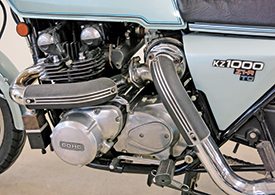
More than a thousand 1978 models were sold, and a few mods were made for ’79, including a flashier paint job, better header design, better lubrication and the boost setting backed down to 6 psi—though still susceptible to non-approved adjustments. Unfortunately, the party-pooping government of California, where the sales were biggest, passed a law prohibiting exhaust modifications on production vehicles. And that was the end of the Z1-R turbo.
Exact figures are hard to come by, but apparently TCC fettled some 1,600 Z1-Rs in the two years they were on the market. Few survive.








